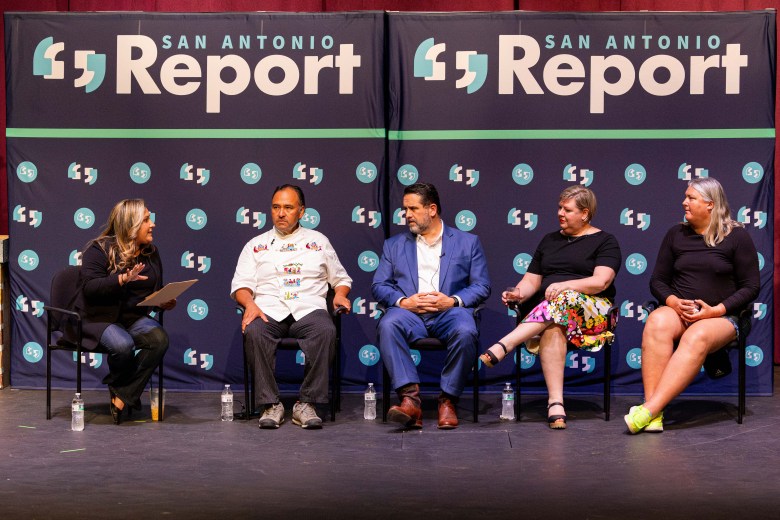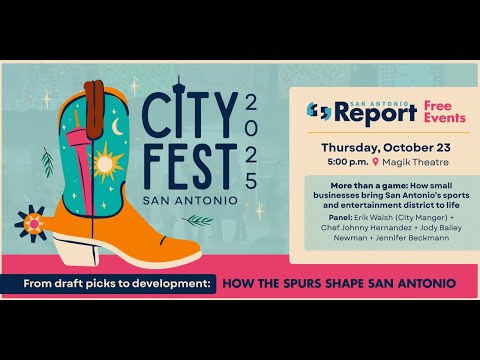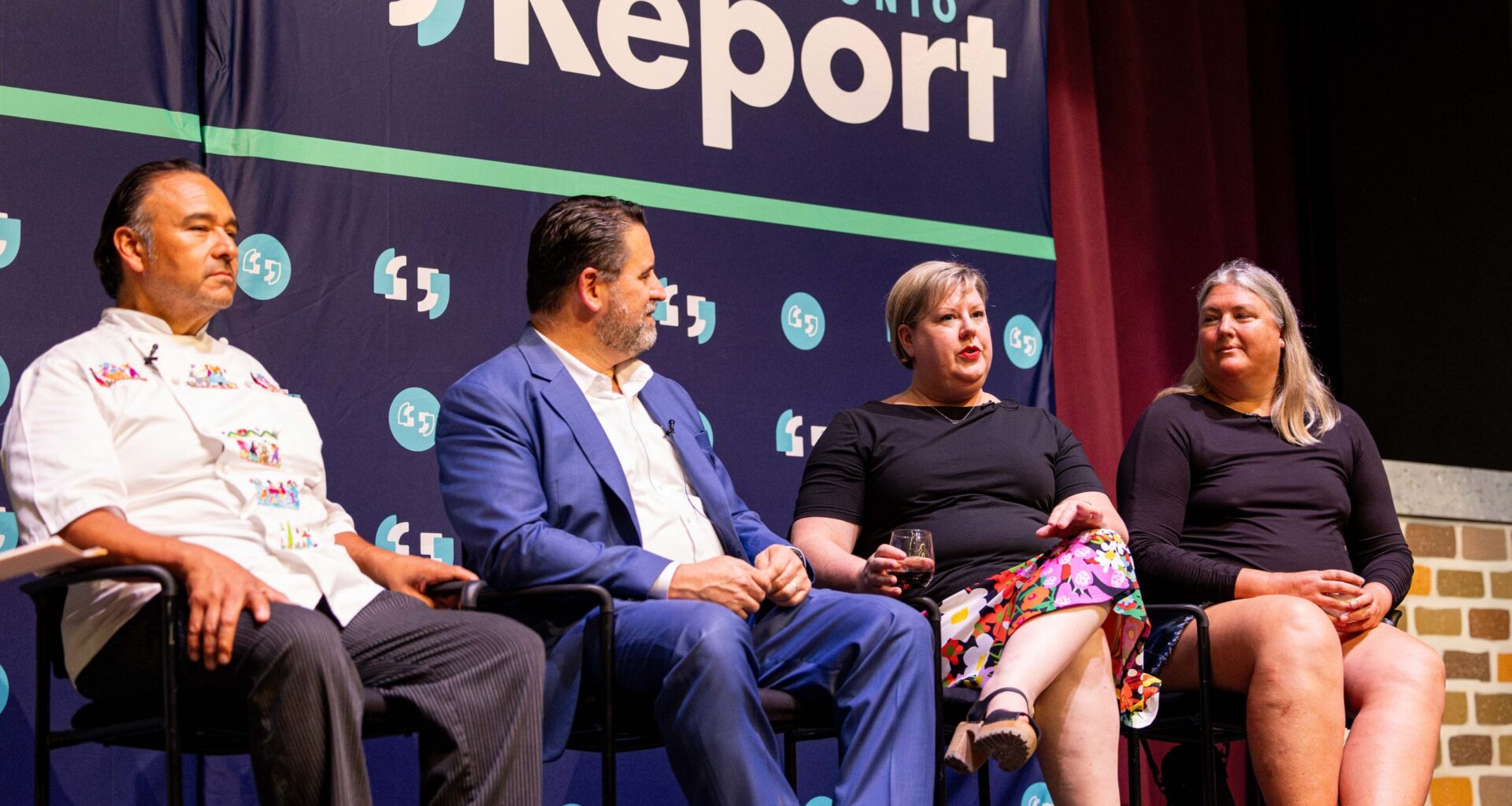The San Antonio Spurs want to build a downtown arena and entertainment district. The City of San Antonio wants to upgrade the Henry B. Gonzalez Convention Center and the Alamodome.
If the full, multi-billion dollar vision of downtown improvements, also known as Project Marvel, comes to pass, what would that mean for the Hemisfair area and the residents and businesses there now, and in the future?
A panel of local business owners and City Manager Erik Walsh discussed the ramifications of construction, new businesses and infrastructure needs in the Hemisfair area at the last event of the San Antonio Report’s CityFest 2025 at the Magik Theatre on Thursday.
“It’s designed to be a broad plan that encompasses from Alamo Street to Cherry Street,” Walsh said. “It’s got to be done thoughtfully. It should be done logically.”
Walsh was joined by Johnny Hernandez, who owns multiple Mexican restaurant concepts across the city, and local business owners Jennifer Beckmann of 210 Urban Winery in Hemisfair and Jody Bailey Newman of the Friendly Spot in Southtown.
Those business owners said they’re in support of the customers and attention a new downtown Spurs arena would bring, but they’re curious about what can be done to help businesses through construction, as well as what kinds of new businesses would accompany the proposed sports and entertainment district that could surround that arena.
“We continuously refer to this as the sports and entertainment district, and we are, by nature, the Hemisfair district. We have spent many years creating Hemisfair,” Beckmann said. “How do we stop the growth of what has now taken close to 10 years to build, this cultural center, and say we’re going to become Sports Park? The evolution is needed, yes, but we have to find a balance.”
Walsh laid out a timeline for the project, which has changed since its inception. A proposed land bridge over U.S. Interstate 37 that’s front-and-center in the Marvel rendering is off the table for now due to a lack of federal support, he said, but such federal funding is “cyclical,” and could come back into the picture down the line.
When asked about the land bridge in a keynote CityFest panel on Tuesday, Mayor Gina Ortiz Jones said the city has already started pausing on federally funded projects that may no longer be feasible under the Trump Administration.
“Large developments like that take time,” Walsh said. “We feel there’s a 60-month timeline to design and build that [arena].”
 San Antonio Report Managing Editor Laura Garcia, left, addresses the panel with a question during the CityFest 2025 closing event at the Magik Theatre on Thursday. Credit: Amber Esparza / San Antonio Report
San Antonio Report Managing Editor Laura Garcia, left, addresses the panel with a question during the CityFest 2025 closing event at the Magik Theatre on Thursday. Credit: Amber Esparza / San Antonio Report
Improvements to the western side of the Henry B. Gonzalez Convention Center would allow it to stay competitive with similar venues across the state, he added, and could happen at the same time.
Street refurbishments in the Hemisfair area have already caused issues for local businesses, dragging on longer than anticipated and making it hard for customers to get to front doors, several panelists noted to San Antonio Report managing editor Laura Garcia, the panel’s moderator.
Hernandez was confident in city leadership and their ability to navigate those challenges on future projects, he said, but the other small business owners shared some of their concerns and needs during the likely years of construction still to come.
“It’s something that has to be thought through to have a light footprint,” Beckmann said. “How do we do this with a light impact. … There’s no small business that can survive years of impact.”
Beckmann and Bailey Newman emphasized that businesses still need easy access. They also discussed what kinds of businesses would go into a sports and entertainment district.
“We want to be sure that there are things in place that eliminate national chains,” Beckmann said. “Will you have things in place to eliminate competitive businesses from a direct district? That’s not yet been answered. These are things that we’re hoping to have more clarification on.”
Requests for information
Local business owners aren’t the only ones asking about what a prospective arena would look like — earlier on Thursday, a local hospitality workers union released a statement asking how much part-time workers at the arena would be paid.
Walsh noted that a non-binding term sheet between the Spurs and the city lays out the team’s contributions and promises if it is to receive public funding. That term sheet includes full-time workers’ wages, but little about local businesses.
What businesses go into and around the arena could largely be up to the Spurs, he added.
“If and when we get to that point, we’ll go through that public process,” Walsh said. “None of that has been decided, none of that has been discussed.”
Those discussions could take place after the Nov. 4 election, he added, when voters will have a chance to vote for or against Bexar County’s portion of public funding for the new arena. Proposition B would allocate $311 million of the county’s venue tax revenue to help build a downtown arena, and city leaders have indicated a desire to keep negotiating with the Spurs regardless of the outcome of the countywide vote.
A final point that all the panelists touched on was parking. Parking in downtown is challenging already, even without a new arena hosting basketball games, Walsh said. It won’t get easier.
“I don’t think we can have any of these conversations without talking about parking,” Beckmann said.
If cheap parking starts to disappear, she asked, could permits or local subsidies be introduced?
The panel was the final event in the San Antonio Report’s 2025 CityFest, which focused on the negotiations, possibilities and ramifications of a downtown Spurs arena as voters weigh the issue in the Nov. 4 election.
Watch the full event:

